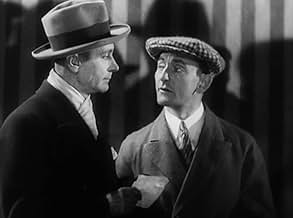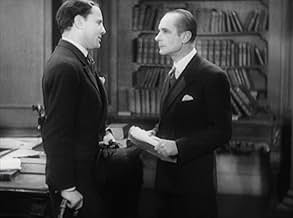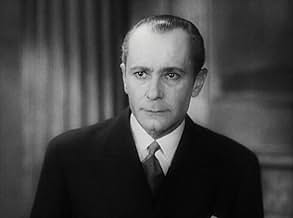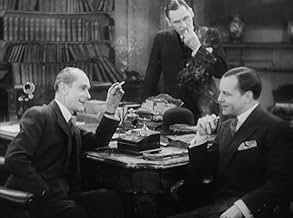Mary
- 1931
- 1h 18min
PUNTUACIÓN EN IMDb
5,7/10
1,1 mil
TU PUNTUACIÓN
Añade un argumento en tu idiomaA juror in a murder trial, after voting to convict, has second thoughts and begins to investigate on his own before the execution.A juror in a murder trial, after voting to convict, has second thoughts and begins to investigate on his own before the execution.A juror in a murder trial, after voting to convict, has second thoughts and begins to investigate on his own before the execution.
- Dirección
- Guión
- Reparto principal
John Mylong
- John Stuart
- (as Jack Mylong-Münz)
Reseñas destacadas
The Hitchcock/Truffaut book,which is actually a very long interview ,something like "the Beatles anthology" in pop music ,gives us many interesting informations about "Mary" ,a movie the master liked.Although he told Truffaut he detested the whodunits ,those riddles a la Agatha Christie,"Mary" featured "things we did for the first time":stream of consciousness,play in the play a la "Hamlet" references to transvestism and even hints at (veiled) homosexuality,which was a "crime" in Great Britain as it was in Germany at the time....
That said,the story drags on a bit and the running time could have been boiled down to one hour,which would have enhanced the really good scenes: IT was Herbert Marshall's first talkie and the scene when he's shaving and thinking for a clue renews the way the detective investigates.The unfinished manuscript is also a very good idea.But the bravura passage remains the final circus.One can also note the scene of the verdict we hear from the empty juror's room.
There are elements which would appear later in Hitchcock's work: the theater ("Stage fright",also a whodunit,btw),of course "Psycho" (a man in drag) and "vertigo" (the finale which makes you feel dizzy).
This is another early Hitchcock which is not only for completists.
That said,the story drags on a bit and the running time could have been boiled down to one hour,which would have enhanced the really good scenes: IT was Herbert Marshall's first talkie and the scene when he's shaving and thinking for a clue renews the way the detective investigates.The unfinished manuscript is also a very good idea.But the bravura passage remains the final circus.One can also note the scene of the verdict we hear from the empty juror's room.
There are elements which would appear later in Hitchcock's work: the theater ("Stage fright",also a whodunit,btw),of course "Psycho" (a man in drag) and "vertigo" (the finale which makes you feel dizzy).
This is another early Hitchcock which is not only for completists.
A woman is found murdered with another woman, Mary Baring, with whom she'd been heard to be arguing, present, in a daze. It seems like an open-and-shut case and Baring is put on trial for murder. During deliberations, 11 of the 12 members think she's guilty. The sceptical one is Sir John Menier who thinks there are holes in the case. However, he is talked round and Baring is found guilty. After the case Menier still has his doubts and wishes he'd been more forceful in arguing against a guilty verdict. He starts to do his own investigating.
In 1930 Alfred Hitchcock released Murder!, an intriguing murder-thriller. While Murder! Was being shot, Hitchcock was simultaneously making Mary, a German-language version of it, using the same sets but German actors. Mary is almost frame-for-frame and word-for-word (once translated!) the same as Murder! Though manages to run 19 minutes shorter. German must be a more succinct language than English...
The end result is almost as good as Murder! An original start, introducing much of the circumstances around the murder via a murder trial and introducing the main character, Menier, through the jury's deliberations.
The plot developments are good and the climax is quite Shakespearean, which is appropriate considering that the setting is the theatre and most of the characters are theatre actors and crew.
I watched the two films less than day apart and Murder! Was fresh in my mind when I watched Mary. Production values seem a bit lower on Mary and Hitchcock makes less use of clever camera angles in Mary. On the plus side, the irritating smash cuts in Murder! Are not there in Mary. Being longer, Murder! Seems more tension-filled too.
The subtitling on the version of Mary I watched was quite shonky, which also detracted from the film.
Now for the big question: why did Hitchcock make a German version of Murder!? I guess that sound in movies was so new and primitive that simply dubbing Murder! Into German wasn't an option. In the silent era a movie could easily be adapted into another language - just change the dialogue cards!
But why bother at all? My guess is that Germany was a large cinematic market and/or Hitchcock had a large fan base in Germany, hence a film specifically for that market. It's like (30 years later) the Beatles re-recording and releasing many of their early stuff in German.
It's worth noting that this was the one and only time Hitchcock made a foreign-language version of one of his movies. Either Mary wasn't as good an idea as he imagined or technology improved and soon after this his films were dubbed or sub-titled for foreign audiences.
In 1930 Alfred Hitchcock released Murder!, an intriguing murder-thriller. While Murder! Was being shot, Hitchcock was simultaneously making Mary, a German-language version of it, using the same sets but German actors. Mary is almost frame-for-frame and word-for-word (once translated!) the same as Murder! Though manages to run 19 minutes shorter. German must be a more succinct language than English...
The end result is almost as good as Murder! An original start, introducing much of the circumstances around the murder via a murder trial and introducing the main character, Menier, through the jury's deliberations.
The plot developments are good and the climax is quite Shakespearean, which is appropriate considering that the setting is the theatre and most of the characters are theatre actors and crew.
I watched the two films less than day apart and Murder! Was fresh in my mind when I watched Mary. Production values seem a bit lower on Mary and Hitchcock makes less use of clever camera angles in Mary. On the plus side, the irritating smash cuts in Murder! Are not there in Mary. Being longer, Murder! Seems more tension-filled too.
The subtitling on the version of Mary I watched was quite shonky, which also detracted from the film.
Now for the big question: why did Hitchcock make a German version of Murder!? I guess that sound in movies was so new and primitive that simply dubbing Murder! Into German wasn't an option. In the silent era a movie could easily be adapted into another language - just change the dialogue cards!
But why bother at all? My guess is that Germany was a large cinematic market and/or Hitchcock had a large fan base in Germany, hence a film specifically for that market. It's like (30 years later) the Beatles re-recording and releasing many of their early stuff in German.
It's worth noting that this was the one and only time Hitchcock made a foreign-language version of one of his movies. Either Mary wasn't as good an idea as he imagined or technology improved and soon after this his films were dubbed or sub-titled for foreign audiences.
This perfunctory German version of MURDER, filmed at the same time on the same sets but with a mostly different cast, is 28 minutes shorter than the English version! It leaves out all of the touches that make the English version enjoyable, and also leaves out some of the clues that lead to the murderer. Some of the things left out are: the jury member who hasn't a clue; the jury foreman having difficulty getting the ballots in the right piles; the jury filing out from the jury room into the court and Sir John waiting before getting up and joining them; the servant bringing the radio into the bathroom, and the colloquy with the servant at that point; the interior monologue is much shorter; dialogue in the scene immediately after is shorter (also, the bathroom and subsequent scene are sequenced wrong so that it seems he's shaving again after he finished); the landlady isn't present when the couple get the call from Sir John, and so the byplay about them owing the rent is not there; their frantic dressing and spiffing up for the Sir John visit; the shot of the stage manager's feet in a super-soft carpet, showing what it feels like to him; the scene where they look at the parlor with landlady is much shorter (and comes after scene where they look at her bedroom); tricking the landlady by using a high-pitched voice; Hitchcock's appearance in the street; tipping the theatre manager after they inspect the theatre; the scene with all the kids is much shorter, with the cat under the covers eliminated (same kids, though); the kids don't sit on the trunk, so the dialogue about the policeman's uniform in the trunk must not be there; the striking overhead shot of Mary in her cell, and the shadow of the noose; Sir John's scene with Mary is shorter, colder, and they don't talk about the theatre at the end; the scene of Sir John and the stage manager in the circus audience, where they talk about trapping the murderer with a Hamlet-like play is much shorter; when the murderer hangs himself, there's a somewhat more dramatic sound editing, perhaps to cover up the fact that he doesn't make a very good noose; the murderer carried out on a stretcher; the sequence of Sir John and Mary in the train is shorter; and the shot of the characters on stage at the end. Some of the jokes are still there but presented in so rudimentary a fashion that one would hardly notice. For example, when Sir John notices that his guest is using a small spoon for the soup, he does the same, and when he puts his martini olive on the tray, the guests don't know what to do with theirs; both these incidents still occur but with no reactions from the actors to point up the gags. Abel looks a lot like Marshall, which is very disconcerting because that British upper-class attitude that informs every aspect of the English version is completely lacking. The stage manager is an expressionless nonentity in this version. It's a second-hand, second-rate copy all through. One can hardly believe Hitchcock himself directed this totally lacking, colorless run-through of his delightful MURDER. You may never get a chance to see this one, which may frustrate Hitchcock completists, but, really, there's absolutely no reason to see it, even if you only understand German! See MURDER a second time instead.
This is the only time in Alfred Hitchcock's career that he remade one of his own films in another language; just like in "Murder" (1930), there is one piece of brilliant filmmaking (the entire jury sequence), but the rest of the film is dull, primitive and plodding - strictly for Hitchcock completists. Mary (Olga Tschechowa) is very beautiful. ** out of 4.
For Hitchcock completists only, this German-language version of the same director's Murder! tells the same story on the same sets, but with different cast, as a juror questions the guilty verdict he helped come to.
A few mildly amusing visual flairs are present here: jurors seated around a circular table. The camera pans along and we see a first juror held deep in thought; the next several are listening with rapt attention; until we arrive at one man who is clearly bored to tears with it all; a mild joke which was thrown in to the German version, not in the UK version. Brief glimpses (again) of cross-dressing, which Hitch later went back to, in a big way, with Psycho.
Some early quick cuts are surprising, eleven cuts in a three seconds-long scene at the twenty three minute mark. Most unconventional at the time.
Overall the movie is watchable, but not very involving, partly at least due to its lax pacing, and a verbose screenplay. Like its UK counterpart, however, it does pick up for its memorable climax.
A few mildly amusing visual flairs are present here: jurors seated around a circular table. The camera pans along and we see a first juror held deep in thought; the next several are listening with rapt attention; until we arrive at one man who is clearly bored to tears with it all; a mild joke which was thrown in to the German version, not in the UK version. Brief glimpses (again) of cross-dressing, which Hitch later went back to, in a big way, with Psycho.
Some early quick cuts are surprising, eleven cuts in a three seconds-long scene at the twenty three minute mark. Most unconventional at the time.
Overall the movie is watchable, but not very involving, partly at least due to its lax pacing, and a verbose screenplay. Like its UK counterpart, however, it does pick up for its memorable climax.
¿Sabías que...?
- CuriosidadesA copy of the film is included as a bonus feature on the Kino Lorber Studio Classics DVD and German DVD releases of Asesinato (1930) and the French DVD release of Posada Jamaica (1939).
- PifiasAs Sir John interviews Mary in jail, it is established in long-shot that both are sitting at opposite ends of a long table. During frontal closeups, the widths of the planks that make up the tabletop reveal that very randomly either the table is turning between shots or both persons repeatedly switch places.
The exact same continuity error also applies to the American version of the movie, Asesinato (1930).
- ConexionesAlternate-language version of Asesinato (1930)
Selecciones populares
Inicia sesión para calificar y añadir a tu lista para recibir recomendaciones personalizadas
Detalles
- Fecha de lanzamiento
- Países de origen
- Idioma
- Títulos en diferentes países
- Secreto de la noche
- Localizaciones del rodaje
- Empresa productora
- Ver más compañías en los créditos en IMDbPro
- Duración1 hora 18 minutos
- Color
- Relación de aspecto
- 1.20 : 1
Contribuir a esta página
Sugerir un cambio o añadir el contenido que falta

Principal laguna de datos
By what name was Mary (1931) officially released in Canada in English?
Responde






























